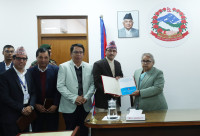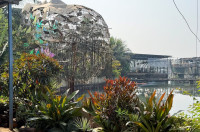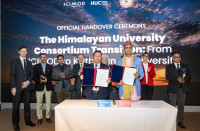National
Locals, entrepreneurs join hands to manage habitat for wild animals in Chitwan
Degradation of habitat has been blamed for clashes between animals, leading to a rise in their mortality inside.
Chandan Kumar Mandal
Tourism entrepreneurs, community forest user groups and buffer zone communities have combined forces to manage grassland for wildlife living inside the Chitwan National Park.
This comes amid reports that grassland inside the park is being degraded. The degradation of natural habitat has led to clashes between wild animals inside the park and forced them to wander outside the conservation area.
“The loss of habitat has forced wild animals to congregate in particular areas where conditions are favourable for them,” said Tika Prasad Kadel, president of National Park Jeep Safari Association. “This leads them to clash amongst themselves. They also come out in search of food, and this causes spikes in human-wildlife conflict,” added Kadel.
The habitat improvement drive, which aims to manage an estimated 60 hectare of land, will take place in various pockets inside the core areas of the park.
They will use grass-cutting machines to make old habitats covered with weed usable.
Drying of water resources and shrinking of grassland, also attributed to the spread of invasive plant species, have been linked to an alarming number of deaths of the greater one-horned rhinos inside the Chitwan National Park.
“Our work has already begun. We cannot only think of earning money from wildlife. Tourism entrepreneurs should also do the needful to protect them,” said Kadel.
Following a rise in the deaths of one-horned rhinos inside Chitwan, which home to 605 rhinos, park authorities have already prioritised habitat improvement and management and creation of wetlands. The Department of National Park and Wildlife Conservation has also introduced a plan to create 700 hectares of new grassland inside the park.
Meanwhile, Prakash Upreti, information officer at Chitwan National Park, said the park has already recovered 100 hectares of grassland and will be creating 600 hectares of new grassland soon.
“The park’s major focus has been on habitat management this year. For this, we are creating water ponds and new areas of grassland,” said Upreti.




 10.12°C Kathmandu
10.12°C Kathmandu















